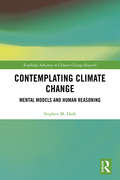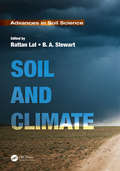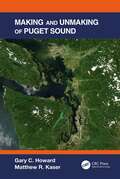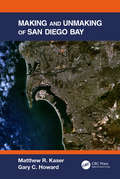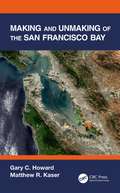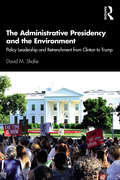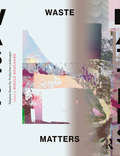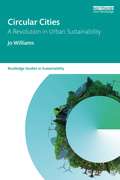- Table View
- List View
Contemplating Climate Change: Mental Models and Human Reasoning (Routledge Advances in Climate Change Research)
by Stephen M. DarkGlobal climate change policy has failed us all, but what is the reasoning that underlies this failure? Why are some people more disposed to reflect on confounding issues like climate change, recognise the danger, seek a solution, and act accordingly, more than others? This book is concerned with how we think and act in response to climate change. In particular, faced with deep uncertainty and the multifaceted complexities that characterise the climate change conundrum, how the various actors and institutions involved in the policymaking process make decisions that both aid and impede in the design and implementation of climate change policy. This book focuses on how these actors and institutions frame and use the knowledge available – under conditions of competing ideologies and interests – and synthesise it to form often-disparate mental models, or worldviews, that inspire them to become firm advocates of meaningful climate change action or indeed, sceptics that continue to downplay the threat, and hence the need for urgency. By exploring how we think about climate change and the disparate mental models we hold as a result, this book explores why humankind has thus far failed in its endeavours to solve the climate change problem. This book will be of great interest to students and scholars of climate change, environmental policy and environmental psychology.
Contemplating Climate Change: Mental Models and Human Reasoning (Routledge Advances in Climate Change Research)
by Stephen M. DarkGlobal climate change policy has failed us all, but what is the reasoning that underlies this failure? Why are some people more disposed to reflect on confounding issues like climate change, recognise the danger, seek a solution, and act accordingly, more than others? This book is concerned with how we think and act in response to climate change. In particular, faced with deep uncertainty and the multifaceted complexities that characterise the climate change conundrum, how the various actors and institutions involved in the policymaking process make decisions that both aid and impede in the design and implementation of climate change policy. This book focuses on how these actors and institutions frame and use the knowledge available – under conditions of competing ideologies and interests – and synthesise it to form often-disparate mental models, or worldviews, that inspire them to become firm advocates of meaningful climate change action or indeed, sceptics that continue to downplay the threat, and hence the need for urgency. By exploring how we think about climate change and the disparate mental models we hold as a result, this book explores why humankind has thus far failed in its endeavours to solve the climate change problem. This book will be of great interest to students and scholars of climate change, environmental policy and environmental psychology.
Evolutionary Biogeography of the Andean Region (CRC Biogeography Series)
by Juan J. MorroneKey features: The first reference book to provide a comprehensive treatment of the biogreography of the Andean region Includes lists of the synonyms for each area and examples of the plant and animal taxa characterizing them. An extensive reference section serves as an entry point for more in-depth research on individual subjects Discusses the relationships between the areas, formulating hypotheses explaining the relationships of different biotas, based on track and cladistic biogeographic analyses Identifies cenocrons that were assembled in the different biotas Contains maps that illustrate the distribution of particular taxa, area cladograms and vegetation profiles This book presents a regionalization of the Andean region, based on an evolutionary biogeographic approach. Aimed at anyone wishing to understand biogeographic patterns of distribution of Andean plants and animals, the book provides a comprehensive treatment of three subregions, one transition zone, and 16 provinces. Lists of the synonyms and examples of taxa characterizing each area are given, and the relationships between the areas discussed, alongside hypotheses explaining the assembly of different biotas. Several maps illustrate the distribution of particular taxa, as well as area cladograms, diagrams and full-color vegetation profiles.
Evolutionary Biogeography of the Andean Region (CRC Biogeography Series)
by Juan J. MorroneKey features: The first reference book to provide a comprehensive treatment of the biogreography of the Andean region Includes lists of the synonyms for each area and examples of the plant and animal taxa characterizing them. An extensive reference section serves as an entry point for more in-depth research on individual subjects Discusses the relationships between the areas, formulating hypotheses explaining the relationships of different biotas, based on track and cladistic biogeographic analyses Identifies cenocrons that were assembled in the different biotas Contains maps that illustrate the distribution of particular taxa, area cladograms and vegetation profiles This book presents a regionalization of the Andean region, based on an evolutionary biogeographic approach. Aimed at anyone wishing to understand biogeographic patterns of distribution of Andean plants and animals, the book provides a comprehensive treatment of three subregions, one transition zone, and 16 provinces. Lists of the synonyms and examples of taxa characterizing each area are given, and the relationships between the areas discussed, alongside hypotheses explaining the assembly of different biotas. Several maps illustrate the distribution of particular taxa, as well as area cladograms, diagrams and full-color vegetation profiles.
Ecology of Fire-Dependent Ecosystems: Wildland Fire Science, Policy, and Management
by Devan Allen McGranahan Carissa L. WonkkaEcology of Fire-Dependent Ecosystems is brimming with intriguing ecological stories of how life has evolved with and diversified within the varied fire regimes that are experienced on earth. Moreover, the book places itself as a communication between students, fire scientists, and fire fighters, and each of these groups will find some familiar ground, and some challenging aspects in this text: something which ultimately will help to bring us closer together and enrich our different approaches to understanding and managing our changing planet. -- Sally Archibald, Professor, University of the Witwatersrand, Johannesburg, South Africa Most textbooks are as dry as kindling and about as much fun to sink your teeth into. This is not that kind of textbook. Devan Allen McGranahan and Carissa L. Wonkka have taken a complex topic and somehow managed to synthesize it into a comprehensive, yet digestible form. This is a book you can read cover to cover – I know, I did it. As a result, I took an enlightening journey through the history and fundamentals of fire and its role in the natural and human world, ending with a thoughtful review of the evolving relationship between humans and wildland fire. -- Chris Helzer, Nebraska Director of Science, The Nature Conservancy, and author of The Prairie Ecologist blog Ecology of Fire-Dependent Ecosystems: Wildland Fire Science, Policy, and Management is intended for use in upper-level courses in fire ecology and wildland fire management and as a reference for researchers, managers, and other professionals involved with wildland fire science, practice, and policy. The book helps guide students and scientists to design and conduct robust wildland fire research projects and critically interpret and apply fire science in any management, education, or policy situation. It emphasizes variability in wildland fire as an ecological regime and provides tools for students, researchers, and managers to assess and connect fire environment and fire behaviour to fire effects. Fire has not only shaped social and ecological communities but pushed ecosystems beyond previous boundaries, yet understanding the nature and effects of fire as an ecological disturbance has been slow, hampered by the complexity of the dynamic interactions between vegetation and climate and the fear of the destruction fire can bring. This book will help those who study, manage, and use wildland fire to develop new answers and novel solutions, based on an understanding of how fire functions in natural and social environments. It reviews literature, synthesizes concepts, and identifies research gaps and policy needs. The text also explores the interaction of fire and human culture, demonstrating how fire policy can be made adaptable to cultural and socio-ecological objectives.
Ecology of Fire-Dependent Ecosystems: Wildland Fire Science, Policy, and Management
by Devan Allen McGranahan Carissa L. WonkkaEcology of Fire-Dependent Ecosystems is brimming with intriguing ecological stories of how life has evolved with and diversified within the varied fire regimes that are experienced on earth. Moreover, the book places itself as a communication between students, fire scientists, and fire fighters, and each of these groups will find some familiar ground, and some challenging aspects in this text: something which ultimately will help to bring us closer together and enrich our different approaches to understanding and managing our changing planet. -- Sally Archibald, Professor, University of the Witwatersrand, Johannesburg, South Africa Most textbooks are as dry as kindling and about as much fun to sink your teeth into. This is not that kind of textbook. Devan Allen McGranahan and Carissa L. Wonkka have taken a complex topic and somehow managed to synthesize it into a comprehensive, yet digestible form. This is a book you can read cover to cover – I know, I did it. As a result, I took an enlightening journey through the history and fundamentals of fire and its role in the natural and human world, ending with a thoughtful review of the evolving relationship between humans and wildland fire. -- Chris Helzer, Nebraska Director of Science, The Nature Conservancy, and author of The Prairie Ecologist blog Ecology of Fire-Dependent Ecosystems: Wildland Fire Science, Policy, and Management is intended for use in upper-level courses in fire ecology and wildland fire management and as a reference for researchers, managers, and other professionals involved with wildland fire science, practice, and policy. The book helps guide students and scientists to design and conduct robust wildland fire research projects and critically interpret and apply fire science in any management, education, or policy situation. It emphasizes variability in wildland fire as an ecological regime and provides tools for students, researchers, and managers to assess and connect fire environment and fire behaviour to fire effects. Fire has not only shaped social and ecological communities but pushed ecosystems beyond previous boundaries, yet understanding the nature and effects of fire as an ecological disturbance has been slow, hampered by the complexity of the dynamic interactions between vegetation and climate and the fear of the destruction fire can bring. This book will help those who study, manage, and use wildland fire to develop new answers and novel solutions, based on an understanding of how fire functions in natural and social environments. It reviews literature, synthesizes concepts, and identifies research gaps and policy needs. The text also explores the interaction of fire and human culture, demonstrating how fire policy can be made adaptable to cultural and socio-ecological objectives.
Soil and Climate: Advances In Soil Science (Advances in Soil Science #Vol. 96)
by Rattan Lal B. A. StewartClimate is a soil-forming factor and soil can mitigate climate change through a reduction in the emissions of greenhouse gases and sequestration of atmospheric CO2. Thus, there is a growing interest in soil management practices capable of mitigating climate change and enhancing environmental quality. Soil and Climate addresses global issues through soil management and outlines strategies for advancing Sustainable Development Goals (SDGs). This volume in the Advances in Soil Science series is specifically devoted to describe state-of-the-knowledge regarding the climate–soil nexus in relation to: Soil Processes: weathering, decomposition of organic matter, erosion, leaching, salinization, biochemical, transformations, gaseous flux, and elemental cycling, Soil Properties: physical, chemical, biological, and ecological, Atmospheric Chemistry: gaseous concentrations of (CO2, CH4, N2O), water vapors, soot, dust, and particulate matter, Mitigation and Adaptation: source and sink of GHGs (CO2, CH4, N2O), land use and soil management, soil C sink capacity, permafrost, Soil Management: sequestration of organic and inorganic C, nutrient requirements, water demands, coupled cycling of H2O, N, P, S, and Policy and Outreach: carbon farming, payments for ecosystem services, COP21, SDGs, land degradation neutrality Special topics on soil as a source or sink of CO2, silicate weathering and carbon sequestration, nutrients required for carbon sequestration, physical protection and the mean resident time, and predicting soil carbon stocks are discussed in detail throughout the book.
Soil and Climate (Advances in Soil Science)
by Rattan Lal B. A. StewartClimate is a soil-forming factor and soil can mitigate climate change through a reduction in the emissions of greenhouse gases and sequestration of atmospheric CO2. Thus, there is a growing interest in soil management practices capable of mitigating climate change and enhancing environmental quality. Soil and Climate addresses global issues through soil management and outlines strategies for advancing Sustainable Development Goals (SDGs). This volume in the Advances in Soil Science series is specifically devoted to describe state-of-the-knowledge regarding the climate–soil nexus in relation to: Soil Processes: weathering, decomposition of organic matter, erosion, leaching, salinization, biochemical, transformations, gaseous flux, and elemental cycling, Soil Properties: physical, chemical, biological, and ecological, Atmospheric Chemistry: gaseous concentrations of (CO2, CH4, N2O), water vapors, soot, dust, and particulate matter, Mitigation and Adaptation: source and sink of GHGs (CO2, CH4, N2O), land use and soil management, soil C sink capacity, permafrost, Soil Management: sequestration of organic and inorganic C, nutrient requirements, water demands, coupled cycling of H2O, N, P, S, and Policy and Outreach: carbon farming, payments for ecosystem services, COP21, SDGs, land degradation neutrality Special topics on soil as a source or sink of CO2, silicate weathering and carbon sequestration, nutrients required for carbon sequestration, physical protection and the mean resident time, and predicting soil carbon stocks are discussed in detail throughout the book.
Making and Unmaking of Puget Sound
by Gary C. Howard Matthew R. KaserThe Puget Sound is a complex fjord-estuary system in Washington State that is connected to the Pacific Ocean by the Juan de Fuca Strait and surrounded by several large population centers. The watershed is enormous, covering nearly 43,000 square kilometers with thousands of rivers and streams. Geological forces, volcanos, Ice Ages, and changes in sea levels make the Sound a biologically dynamic and fascinating environment, as well as a productive ecosystem. Human activity has also influenced the Sound. Humans built several major cities, such as Seattle and Tacoma, have dramatically affected the Puget Sound. This book describes the natural history and evolution of Puget Sound over the last 100 million years through the present and into the future. Key Features Summarizes a complex geological, geographical, and ecological history Reviews how the Puget Sound has changed and will likely change in the future Examines the different roles of various drivers of the Sound’s ecosystem function Includes the role of humans—both first people and modern populations. Explores Puget Sound as an example of general bay ecological and environmental issues
Making and Unmaking of Puget Sound
by Gary C. Howard Matthew R. KaserThe Puget Sound is a complex fjord-estuary system in Washington State that is connected to the Pacific Ocean by the Juan de Fuca Strait and surrounded by several large population centers. The watershed is enormous, covering nearly 43,000 square kilometers with thousands of rivers and streams. Geological forces, volcanos, Ice Ages, and changes in sea levels make the Sound a biologically dynamic and fascinating environment, as well as a productive ecosystem. Human activity has also influenced the Sound. Humans built several major cities, such as Seattle and Tacoma, have dramatically affected the Puget Sound. This book describes the natural history and evolution of Puget Sound over the last 100 million years through the present and into the future. Key Features Summarizes a complex geological, geographical, and ecological history Reviews how the Puget Sound has changed and will likely change in the future Examines the different roles of various drivers of the Sound’s ecosystem function Includes the role of humans—both first people and modern populations. Explores Puget Sound as an example of general bay ecological and environmental issues
Making and Unmaking of San Diego Bay
by Matthew R. Kaser Gary C. HowardSan Diego Bay is a shallow estuary surrounded by a large population center. Geological forces and changes in sea levels from the last Ice Age combine to make the Bay and the adjacent highlands and mesas. Human activity has also influenced the Bay. Humans built several major cities and filled significant parts of the Bay. This book describes the natural history and evolution of the San Diego Bay Area over the last 50 million years through the present and into the future. Key Features Summarizes a complex geological, geographical, and ecological history Reviews how the San Diego Bay has changed and will likely change in the future Examines the different roles of various drivers of Bay ecosystem function Includes the role of humans—both first people and modern populations—on the Bay Explores San Diego Bay as an example of general bay ecological and environmental issues Related Titles Howard GC and Kaser MR. Making and Unmaking of the San Francisco Bay (ISBN 9781138596726) Wang Y, ed. Remote Sensing of Coastal Environments (ISBN 978-1-1381-1638-2) Gonenc IE, Wolfin JB, eds. Coastal Lagoons: Ecosystem Processes and Modeling for Sustainable Use and Development (ISBN 978-0-3675-7814-5) Mossop E, ed. Sustainable Coastal Design and Planning (ISBN 978-0-3675-7075-0)
Making and Unmaking of San Diego Bay
by Matthew R. Kaser Gary C. HowardSan Diego Bay is a shallow estuary surrounded by a large population center. Geological forces and changes in sea levels from the last Ice Age combine to make the Bay and the adjacent highlands and mesas. Human activity has also influenced the Bay. Humans built several major cities and filled significant parts of the Bay. This book describes the natural history and evolution of the San Diego Bay Area over the last 50 million years through the present and into the future. Key Features Summarizes a complex geological, geographical, and ecological history Reviews how the San Diego Bay has changed and will likely change in the future Examines the different roles of various drivers of Bay ecosystem function Includes the role of humans—both first people and modern populations—on the Bay Explores San Diego Bay as an example of general bay ecological and environmental issues Related Titles Howard GC and Kaser MR. Making and Unmaking of the San Francisco Bay (ISBN 9781138596726) Wang Y, ed. Remote Sensing of Coastal Environments (ISBN 978-1-1381-1638-2) Gonenc IE, Wolfin JB, eds. Coastal Lagoons: Ecosystem Processes and Modeling for Sustainable Use and Development (ISBN 978-0-3675-7814-5) Mossop E, ed. Sustainable Coastal Design and Planning (ISBN 978-0-3675-7075-0)
Making and Unmaking of the San Francisco Bay
by Gary C. Howard Matthew R. KaserSan Francisco Bay is a shallow estuary surrounded by a large population center. The forces that built it began with plate tectonics and involved the collision of the Pacific and North American plates and the subduction of the Juan de Fuka plate. Changes in the climate resulting from the last ice age yielded lower and then higher sea levels. Human activity influenced the Bay. Gold mining during the California gold rush sent masses of slit into the Bay. Humans have also built several major cities and filled significant parts of the Bay. This book describes the natural history and evolution of the SF Bay Area over the last 50 million years through the present and into the future. Key selling features: Summarizes a complex geological, geographical and ecological history Reviews how the San Francisco Bay has changed and will likely change in the future Examines the different roles and various drivers of Bay ecosystem function Includes the role of humans - both first peoples and modern populations - on the Bay Explores San Francisco Bay as an example of general bay ecolgical and environmental issues
Making and Unmaking of the San Francisco Bay
by Gary C. Howard Matthew R. KaserSan Francisco Bay is a shallow estuary surrounded by a large population center. The forces that built it began with plate tectonics and involved the collision of the Pacific and North American plates and the subduction of the Juan de Fuka plate. Changes in the climate resulting from the last ice age yielded lower and then higher sea levels. Human activity influenced the Bay. Gold mining during the California gold rush sent masses of slit into the Bay. Humans have also built several major cities and filled significant parts of the Bay. This book describes the natural history and evolution of the SF Bay Area over the last 50 million years through the present and into the future. Key selling features: Summarizes a complex geological, geographical and ecological history Reviews how the San Francisco Bay has changed and will likely change in the future Examines the different roles and various drivers of Bay ecosystem function Includes the role of humans - both first peoples and modern populations - on the Bay Explores San Francisco Bay as an example of general bay ecolgical and environmental issues
Global Biodiversity: Volume 1: Selected Countries in Asia
by T. PullaiahThis is the first volume in the new multi-volume set, Global Biodiversity. Each volume in this series aims to provide insightful information on the biodiversity of selected nations in particular regions. The volumes summarize the available data on both wild and cultivated plants, wild and domesticated animals, and microbes of the different nations. Global Biodiversity, Volume 1: Selected Countries in Asia focuses on selected countries of Asia, providing an abundance of biodiversity information on Afghanistan, Bangladesh, India, Indonesia, Iran, Iraq, Japan, Lebanon, Malaysia, Mongolia, Myanmar, Nepal, and Vietnam. The first chapter in the volume provides an informative overview of what is biodiversity along with biogeographic classifications. It provides explanations of biodiversity patterns and species number; biodiversity conservation, protection, and international commitments and cooperation; biodiversity threats and drivers of change (such as human population growth, climate change, land use change); and the economics of biodiversity as well.
Global Biodiversity: Volume 1: Selected Countries in Asia
by T. PullaiahThis is the first volume in the new multi-volume set, Global Biodiversity. Each volume in this series aims to provide insightful information on the biodiversity of selected nations in particular regions. The volumes summarize the available data on both wild and cultivated plants, wild and domesticated animals, and microbes of the different nations. Global Biodiversity, Volume 1: Selected Countries in Asia focuses on selected countries of Asia, providing an abundance of biodiversity information on Afghanistan, Bangladesh, India, Indonesia, Iran, Iraq, Japan, Lebanon, Malaysia, Mongolia, Myanmar, Nepal, and Vietnam. The first chapter in the volume provides an informative overview of what is biodiversity along with biogeographic classifications. It provides explanations of biodiversity patterns and species number; biodiversity conservation, protection, and international commitments and cooperation; biodiversity threats and drivers of change (such as human population growth, climate change, land use change); and the economics of biodiversity as well.
Global Biodiversity: Volume 2: Selected Countries in Europe
by T. PullaiahThis is the second volume in the new multi-volume set, Global Biodiversity.Each volume in this series covers the biodiversity of a selection of nations in particular regions of the world. The volumes discuss and summarize the available information on both wild and cultivated plants, wild and domesticated animals, and the variety of microbes of the different nations. Global Biodiversity, Volume 2: Selected Countries in Europe looks at the biodiversity of selected countries of Europe, providing an abundance of biodiversity information on Bosnia-Herzegovina, France, George, Greece, Hungary, Italy, Norway, Serbia, Slovakia, Sweden, Turkey, and the United Kingdom. Each chapter features a different country and is written by research scientists and conservationists. The information covers geographical status, ecosystem diversity, species diversity, genetic diversity, and conservation efforts in that particular country. The authors provide statistical data on plants, animals, and microbes of that country along with genetic diversity with the focus on crop plants/cultivated plants and domesticated animals and their wild relatives.
Global Biodiversity: Volume 2: Selected Countries in Europe
by T. PullaiahThis is the second volume in the new multi-volume set, Global Biodiversity.Each volume in this series covers the biodiversity of a selection of nations in particular regions of the world. The volumes discuss and summarize the available information on both wild and cultivated plants, wild and domesticated animals, and the variety of microbes of the different nations. Global Biodiversity, Volume 2: Selected Countries in Europe looks at the biodiversity of selected countries of Europe, providing an abundance of biodiversity information on Bosnia-Herzegovina, France, George, Greece, Hungary, Italy, Norway, Serbia, Slovakia, Sweden, Turkey, and the United Kingdom. Each chapter features a different country and is written by research scientists and conservationists. The information covers geographical status, ecosystem diversity, species diversity, genetic diversity, and conservation efforts in that particular country. The authors provide statistical data on plants, animals, and microbes of that country along with genetic diversity with the focus on crop plants/cultivated plants and domesticated animals and their wild relatives.
Mangroves for Building Resilience to Climate Change
by R.N. Mandal R. BarThis valuable book is a comprehensive volume on mangroves, with information accessible to both botany professionals and students. It provides an easy method of identifying mangroves and distinguishing one species from another. What is a mangrove and what are the criteria of mangroves are explained, along with descriptions of distinctions among major mangroves, mangrove associates, mangrove halophytes, and back mangals. Many photos and illustrations are provided, showing the visible features of mangroves. The volume also covers a range of other topics, including habitats and climatic conditions, morphological and reproductive features, how climate change is affecting mangroves and methods of mitigation and conservation. This book is about mangroves, the intertidal coastal forests that struggle every moment against hungry tides because mangroves flourish at the interface zone of land and sea. Like an evergreen forest in the tropical and subtropical regions of the world, mangroves form definite coastal vegetation, providing protection to people living in such fragile zones against the occurrence of frequent natural calamities. Key features: Introduces important facts about mangroves: definition, early records of mangroves, categorization, and more Looks at the distribution of mangroves worldwide along with features of mangrove habitats and climatic conditions Describes the ecology and environmental conditions, particularly the concept of intertidal zones along estuary positions where tidal flows inundate mangroves Discusses the distinct morphological attributes and reproductive phenology of major mangroves Details the attributes of mangroves, covering a total of 78 species of intertidal flora, including 32 true mangroves, along with their diagnostic features, salient attributes, and illustrations for easy identification Highlights the burning environmental issue of climate change and its impact on mangroves Provides a variety of methods of restoration, conservation, and protection of mangroves
Mangroves for Building Resilience to Climate Change
by R.N. Mandal R. BarThis valuable book is a comprehensive volume on mangroves, with information accessible to both botany professionals and students. It provides an easy method of identifying mangroves and distinguishing one species from another. What is a mangrove and what are the criteria of mangroves are explained, along with descriptions of distinctions among major mangroves, mangrove associates, mangrove halophytes, and back mangals. Many photos and illustrations are provided, showing the visible features of mangroves. The volume also covers a range of other topics, including habitats and climatic conditions, morphological and reproductive features, how climate change is affecting mangroves and methods of mitigation and conservation. This book is about mangroves, the intertidal coastal forests that struggle every moment against hungry tides because mangroves flourish at the interface zone of land and sea. Like an evergreen forest in the tropical and subtropical regions of the world, mangroves form definite coastal vegetation, providing protection to people living in such fragile zones against the occurrence of frequent natural calamities. Key features: Introduces important facts about mangroves: definition, early records of mangroves, categorization, and more Looks at the distribution of mangroves worldwide along with features of mangrove habitats and climatic conditions Describes the ecology and environmental conditions, particularly the concept of intertidal zones along estuary positions where tidal flows inundate mangroves Discusses the distinct morphological attributes and reproductive phenology of major mangroves Details the attributes of mangroves, covering a total of 78 species of intertidal flora, including 32 true mangroves, along with their diagnostic features, salient attributes, and illustrations for easy identification Highlights the burning environmental issue of climate change and its impact on mangroves Provides a variety of methods of restoration, conservation, and protection of mangroves
The Administrative Presidency and the Environment: Policy Leadership and Retrenchment from Clinton to Trump
by David M. ShafieThe growth of the administrative state and legislative gridlock has placed the White House at the center of environmental policymaking. Every recent president has continued the trend of relying upon administrative tools and unilateral actions to either advance or roll back environmental protection policies. From natural resources to climate change and pollution control, presidents have more been willing to test the limits of their authority, and the role of Congress has been one of reacting to presidential initiatives. In The Administrative Presidency and the Environment: Policy Leadership and Retrenchment from Clinton to Trump, David M. Shafie draws upon staff communications, speeches and other primary sources. Key features include detailed case studies in public land management, water quality, toxics, and climate policy, with particular attention to the role of science in decisionmaking. Finally, he identifies the techniques from previous administrations that made Trump’s administrative presidency possible. Shafie’s combination of qualitative analysis and topical case studies offers advanced undergraduate students and researchers alike important insights for understanding the interactions between environmental groups and the executive branch as well as implications for future policymaking.
The Administrative Presidency and the Environment: Policy Leadership and Retrenchment from Clinton to Trump
by David M. ShafieThe growth of the administrative state and legislative gridlock has placed the White House at the center of environmental policymaking. Every recent president has continued the trend of relying upon administrative tools and unilateral actions to either advance or roll back environmental protection policies. From natural resources to climate change and pollution control, presidents have more been willing to test the limits of their authority, and the role of Congress has been one of reacting to presidential initiatives. In The Administrative Presidency and the Environment: Policy Leadership and Retrenchment from Clinton to Trump, David M. Shafie draws upon staff communications, speeches and other primary sources. Key features include detailed case studies in public land management, water quality, toxics, and climate policy, with particular attention to the role of science in decisionmaking. Finally, he identifies the techniques from previous administrations that made Trump’s administrative presidency possible. Shafie’s combination of qualitative analysis and topical case studies offers advanced undergraduate students and researchers alike important insights for understanding the interactions between environmental groups and the executive branch as well as implications for future policymaking.
Waste Matters: Adaptive Reuse for Productive Landscapes
by Nikole BouchardFor thousands of years humans have experimented with various methods of waste disposal—from burning and burying to simply packing up and moving in search of an unscathed environment. Habits of disposal are deeply ingrained in our daily lives, so casual and continual that we rarely ever stop to ponder the big-picture effects on social, spatial and ecological orders. Rethinking the ways in which we produce, collect, discard and reuse our waste, whether it’s materials, spaces or places, is essential to ensure a more feasible future. Waste Matters: Adaptive Reuse for Productive Landscapes presents a series of historical and contemporary design ideas that reimagine a range of repurposed materials at diverse scales and in various contexts by exploring methods of hacking, disassembly, reassembly, recycling, adaptive reuse and preservation of the built environment. Waste Matters will inspire designers to sample and rearrange bits of artifacts from the past and present to produce culturally relevant and ecologically sensitive materials, objects, architecture and environments.
Waste Matters: Adaptive Reuse for Productive Landscapes
by Nikole BouchardFor thousands of years humans have experimented with various methods of waste disposal—from burning and burying to simply packing up and moving in search of an unscathed environment. Habits of disposal are deeply ingrained in our daily lives, so casual and continual that we rarely ever stop to ponder the big-picture effects on social, spatial and ecological orders. Rethinking the ways in which we produce, collect, discard and reuse our waste, whether it’s materials, spaces or places, is essential to ensure a more feasible future. Waste Matters: Adaptive Reuse for Productive Landscapes presents a series of historical and contemporary design ideas that reimagine a range of repurposed materials at diverse scales and in various contexts by exploring methods of hacking, disassembly, reassembly, recycling, adaptive reuse and preservation of the built environment. Waste Matters will inspire designers to sample and rearrange bits of artifacts from the past and present to produce culturally relevant and ecologically sensitive materials, objects, architecture and environments.
Circular Cities: A Revolution in Urban Sustainability (Routledge Studies in Sustainability)
by Jo WilliamsWith cities striving to meet sustainable development goals, circular urban systems are gaining momentum, especially in Europe. This research-based book defines the circular city and circular development. It explains the shift in focus from a purely economic concept, which promotes circular business models in cities, to one that explores a new approach to urban development. This approach offers huge opportunities and addresses important sustainability issues: resource consumption and waste; climate change; the health of urban populations; social inequalities and the creation of sustainable urban economies. It examines the different approaches to circular development, drawing on research conducted in four European cities: Amsterdam, London, Paris and Stockholm. It explores different development pathways and levers for a circular urban transformation. It highlights the benefits of adopting a circular approach to development in cities, but acknowledges that these benefits are not shared equally across society. Finally, it focuses on the challenges to implementing circular development faced by urban actors. This ground-breaking book will be essential reading to scholars, students, practitioners and policymakers interested in the circular economy, urban sustainability, urban ecology, urban planning, urban regeneration, urban resilience, adaptive cities and regenerative cities.
